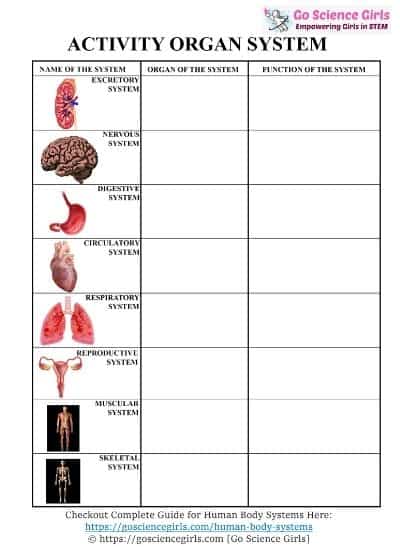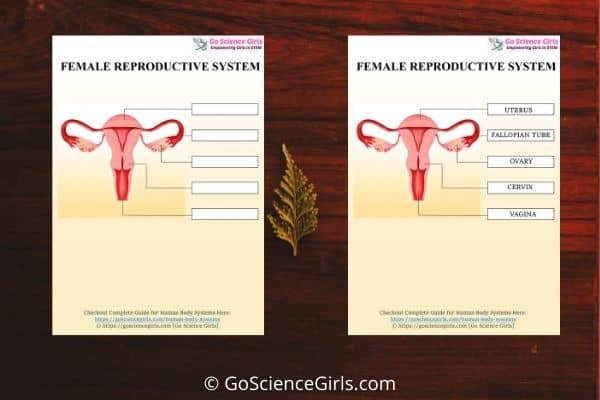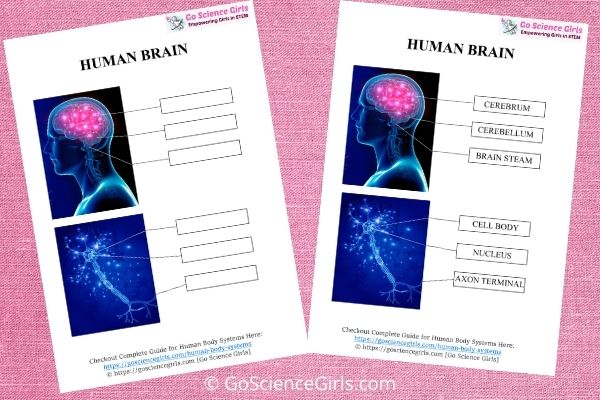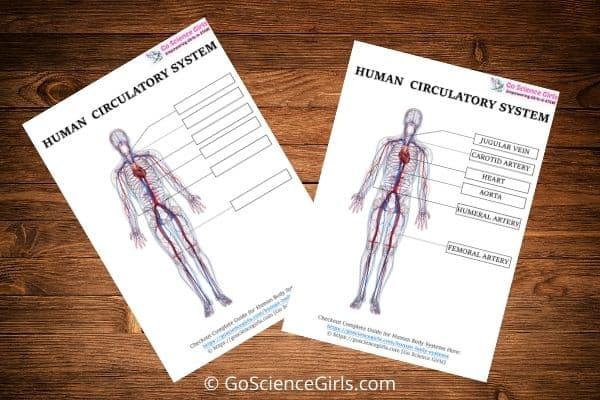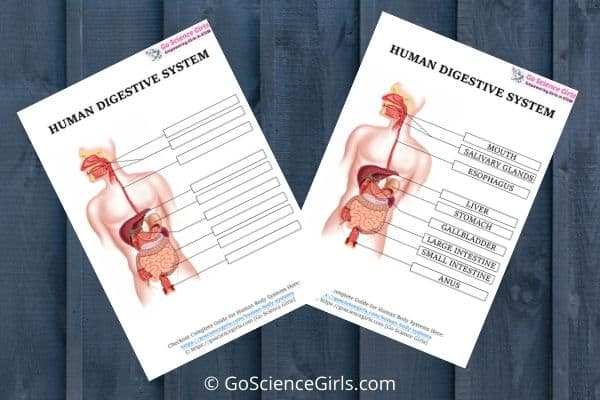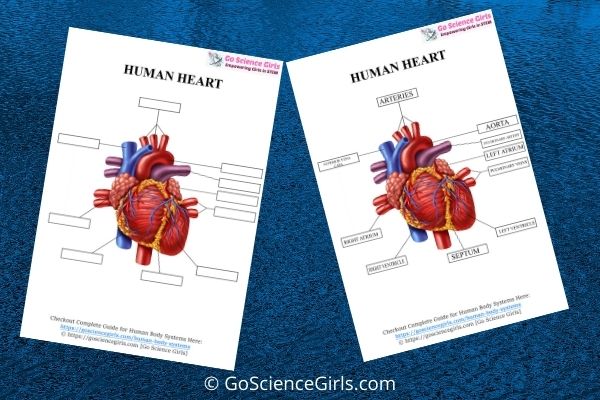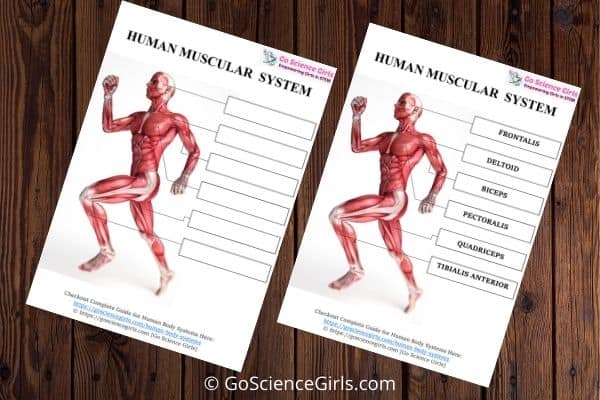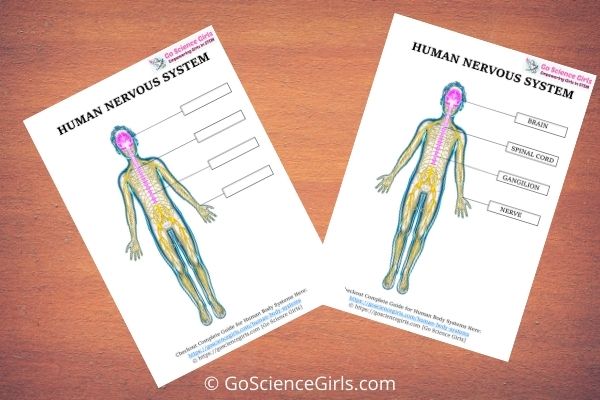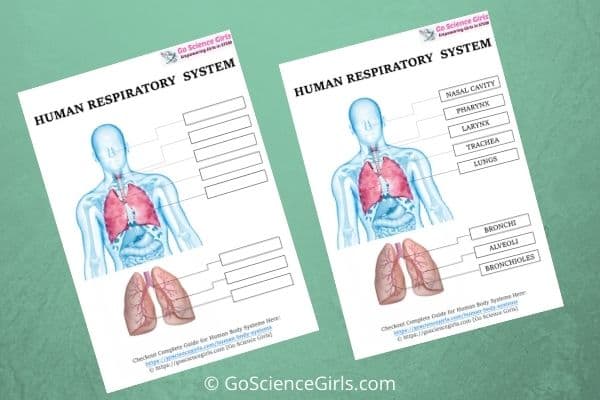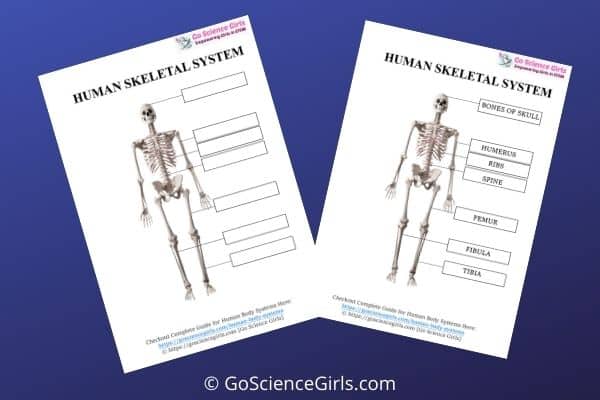A human body comprises specifically 11 body systems. It can be called that a human body is working perfectly stable when all these 11 body systems are working in coordination. The body is known to be imbalanced if any organ malfunctions or suffers an injury somehow.
Our body is a complex combination of cells which come together to form organs. These organs come together and form human body systems. You might be aware of the body’s five senses that are, sight (eyes), smell (nose), touch (skin), taste (tongue) and hearing (ears).
Human Body Systems
All five of these senses are capable of fully functioning only if their respective systems function properly. The list of 11 body systems is given below:
- Circulatory System
- Respiratory System
- Muscular System
- Digestive System
- Nervous System
- Skeletal System
- Endocrine System
- Urinary System
- Immune System
- Reproductive System
- Integumentary System
In this lesson, we will be learning a few important ones. Read along to know the important systems of our human body.
Heart and Circulatory System
The circulatory system is responsible for circulating or supplying blood to each organ of the body and to each and every cell. Blood consists of nutrients that the body needs on a daily basis to function properly. These nutrients are supplied to the organs and the cells by the circulatory system.
Body Parts and Organs of Circulatory System
The human body system consists of organs which are made of millions of cells. The list of organs and their functions are mentioned below.
- Heart
- Blood Vessels
- Blood (fluid, not an organ)
These organs function together for an efficient supply of nutrient-rich blood to various parts of the body. Along with nutrients, blood carries oxygen too. This means that the circulatory system is interconnected to the respiratory system. Don’t worry! We will talk about the respiratory system a little later.
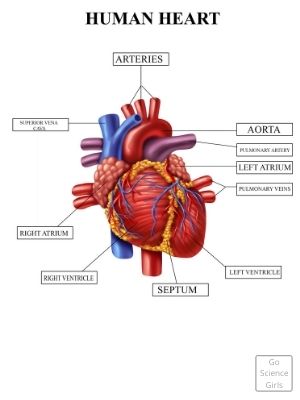
Function of Parts in the Circulatory system
Below are mentioned the functions of each organ in the circulatory system.
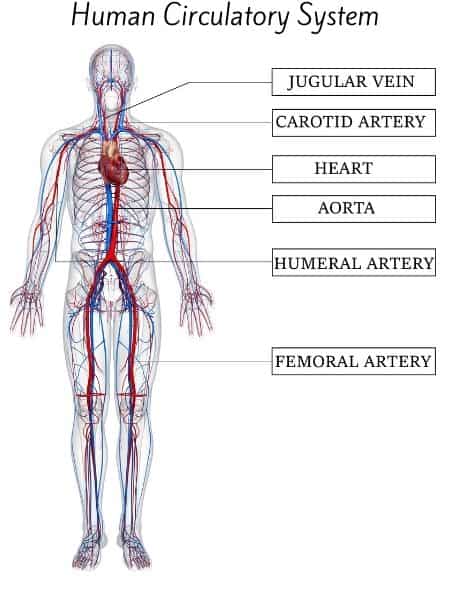
- Heart:
The heart’s job is to pump blood throughout the body. Have you ever felt your heartbeat? You might have, after running or playing football with your friends! The heart has to beat very fast in order to pump blood from your head to your toes.
The heart is a busy organ. It pumps 60 to 100 times every minute while all you’re doing is sleeping. It carries the oxygen provided by the lungs by dissolving it in blood to the cells of our body. Let’s talk about blood!
- Blood:
Blood is far more than just a red liquid. It consists of a watery substance called plasma. Plasma consists of two types of blood cells. Those are, Red Blood Cells (RBCs) and White Blood Cells (WBCs). The reason behind the red colour of our blood is the red blood cells.
The white blood cells are responsible to kill the germs that enter through wounds. When you suffer from a cut or a bleeding wound, the white blood cells in the blood kill the germs and protect the wound from housing bacteria.
Blood also contains platelets. Platelets are responsible to seal off any opening in the body caused by injuries. The solidified blood you see over your wound is nothing but the work of platelets.
- Blood Vessels:
You might have heard the word ‘vessels’. You use them to store food, right? Similarly, blood vessels store and transport blood throughout the body. They are elastic, tubular structures that connect the heart to each and every cell of the body.There are two types of blood vessels in the circulatory system. Those are arteries and veins.
What is the difference between arteries and veins? Arteries are much thicker than veins. The reason is, arteries transport blood directly from the heart. To withstand the strong beating of the heart, arteries need to be thicker. Veins do not have to undergo the pressure applied by the heart. Hence, they are thinner than arteries.
The veins in the human body, if stretched out, can cover up to 60,000 miles. Shocking, Isn’t it? The heart pumps blood and this blood is carried away from the heart by the arteries which thin down into veins to supply blood to each and every cell of the body. Since there is coordination between more than one organ to complete a single task, it is called the circulating system of the human body.
Muscles and Muscular System
We have over 600 muscles in our body. Muscles are attached to bones and help them to move. To cause any physical action, we require muscles in our body. They help us interact with our surroundings and other human beings.
Some muscles work without our permission, like the beating of our heart. The motions caused by such muscles are called involuntary motions. Motions caused by muscles that you can control are called voluntary motions.
Muscles work by contracting and relaxing which causes movement of bones. Say, your teacher asks you to run from one point to the other. Your brain signals your muscle fibres and the muscles use energy and nutrients provided by the blood vessels. Due to this energy, you are finally able to run.
Body Parts in the Muscular system
Just like there are organs in the circulatory system, we have different types of muscles in the muscular system. The list is given below:
- Skeletal Muscles
- Smooth Muscles
- Cardiac Muscles
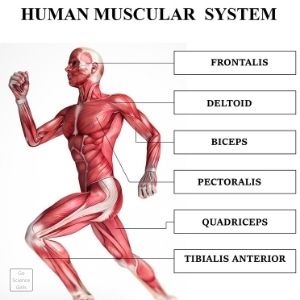
The function of Parts in Muscular system
Each type of muscle is situated in particular parts of our body having peculiar functions. The functions of each kind of muscle are mentioned below.
- Skeletal Muscles
These are muscles we use for voluntary motions. They are tightly attached to bones and produce enough energy for daily motion. Since they deal with voluntary motions, they are connected to the nervous system. The nerve signals from the nervous system send impulses or messages which finally result in motion.
- Smooth Muscles
Smooth muscles do not need the support of bones. They are not attached to our skeleton as these muscles do not cause voluntary actions. Smooth muscles are responsible for causing involuntary motions.
Involuntary motions such as breathing and swallowing are caused by smooth muscles. These muscles have no cross stripes and have a simple structure compared to skeletal muscles. It is a part of most of the human body systems and organs.
- Cardiac Muscles
Cardiac muscles are basically what the heart is made up of. This muscle is only seen in the heart and nowhere else in the body. These are strong muscles that withstand the high pumping of the heart.
Muscles and the muscular system play a very vital role in performing actions. Some can be controlled by the nerves some simply can’t.
Bones and Skeletal System
The skeletal system is the bodyguard of our body. It protects all the sensitive and delicate organs in our body and keeps us in shape. From your head to the toes, skeletons along with the muscles hold your body upright. It supports the overall shape and size of your body.
The adult human being has a skeletal system consisting of around 206 bones. These bones are connected by ball and socket joints. Bones need calcium and iron to grow stronger and work properly. That is why you must finish your vegetables and drink that glass of milk. It will only make you stronger and taller.
Body Parts in the Skeletal System
Following are the different parts of the skeletal system:
- Spine
- Ribs
- Skull
- Hands
- Legs
The function of Parts in Skeletal System
This set of bone systems play a very vital role in protecting important organs like the heart and lungs. The specific functions for each part of the bone system are given below.
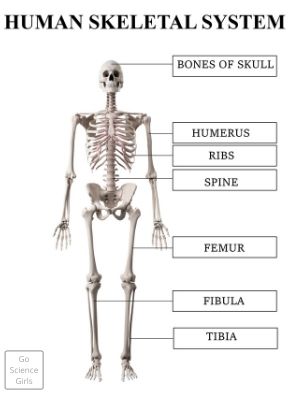
- Spine
The spine lets you twist and turn your upper body. It lets you bend and lift heavy objects off the floor. It is the easiest part of the skeletal system to be felt by our fingers. You can feel the bumps of the spine when you trace your fingers along with it.
The spinal cord is almost, as long as our upper body and is tubular in shape.
The spine is not a single bone but it is made up of around 33 bones. Each bone is shaped like a disc, aligned one below the other.
The spine connects the skull. It is also a cluster of nerves that then spread throughout the body for the transmission of signals from our brain..
- Ribs
Ribs are bone cases that protect the lungs, heart and liver. They are also called rib cage because they are shaped like a cage enclosing the organs. To feel the bottom of your ribcage, lay down on your back and breath heavily, then try tracing the bone beside your stomach
.
The ribcage is firmly connected to the shoulder bones and spine to avoid any jerks and sudden shocks that could affect the lungs and the heart.
- Skull
The skull is responsible for the protection of one of the most important organs of our body, the brain. The brain is a muscular, jelly-like organ and the skull keeps it safe inside. There is a slimy gel like substance between the skull and the brain that absorbs all the shocks and jerks experienced by the skull. A skull injury could be dangerous for the brain and would result in malfunctioning of the nervous system.
You can feel the bottom part of your skull if you tilt your head low and trace your fingers to the back of your neck. The bone you feel beneath your eyes, your nose and your chin are the parts of the skull. Fun fact, your lower jaw is the only bone of the skull that you can move.
- Hands
Your arms are connected to your fingers with the wrist in the middle. The bones of your fingers help you pick up and throw objects just by sending signals from the brain to the muscles in your fingers.
Your palm has five bones and each bone has three smaller bones, except your thumbs. All the bones are a bit thicker and wider in the middle and thinner at the joints. This is because the strength needed for us to lift objects fall directly in the middle of the bone. So next time you pick up or throw an object, imagine the stress you apply on your bones.
- Legs
Your legs are attached to your hips that are right below your waist. Jumping, running and even standing require bones. There are three parts that comprise the leg bone. The bone that goes from your waist to your knees is known as the longest bone of your body. The knee is a ball and socket joint and a triangular shaped bone called the kneecap protects it. The bone below the knee is connected to the foot bone.
Some people have flat feet bone and some have it curved. The feet bone allows us to have a stable balance while running and standing. Like the bones of hands, the leg bones are wider in the middle to undergo stress or pressure while running, walking or standing.
Brain and Nervous System
The brain and the nervous system help the different parts and organs of the body to communicate and interact with each other. There are 11 body systems and the nervous system does a great job at making sure every system coordinates with the other systems.
Parts in the Nervous System system
It consists of the brain, situated inside the skull, the spinal cord (which is also part of the skeletal system), and a large network of nerves. Each part of the nervous system is interconnected. Through this connection, they transmit nerve signals which finally reach our muscles and result in motion.
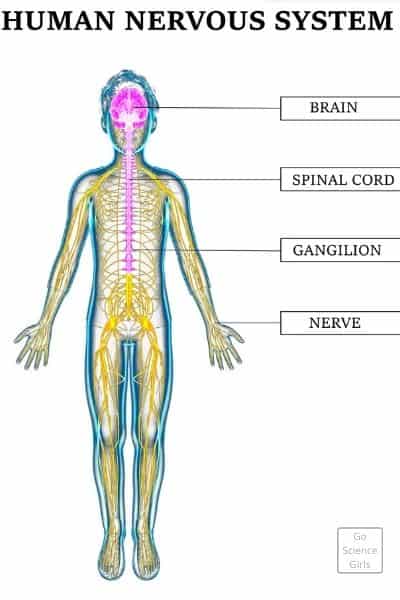
The function of Parts in then Nervous System
Nerve signals result in motion and pick up information through the five senses we discussed above. A part of the nervous system handles the involuntary motions in our body. The functions of each part of the nervous system are mentioned below.

- Motor Nerves
Motor nerves deal with muscles responsible for motion. The nervous system sends signals to muscles through the motor nerves. On receiving signals from the motor nerves, the muscles contract or expand which results in motion.
- Sensory Nerves
The five senses- touch, smell, taste, sight and hearing are all controlled by the sensory nerves in the nervous system. They are highly active all the time and pick up senses and carry them to the brain. These signals only go in one direction, from sensory organs to the brain.
When you touch a vessel filled with hot, boiling water, you immediately withdraw your hand. What actually happens is, you touch the vessel and in a fraction of a second, the sensory nerves pick up a signal and send it to the brain saying that the vessel is too hot. The brain fixes this problem by sending signals to the motor nerves to withdraw your hand immediately.
Imagine how fast the nervous system works! It is astonishing!
- Autonomic System
These are the set of nerves that work without making any physical change as such in your body. These parts are always at work, even if you are in a deep sleep. The autonomic nervous system is responsible for releasing vital enzymes and secretions in our body like saliva and other digestive juices.
They chemically protect our organs by modulating the amount of secretion of juices in the body. If the secretions are more than required, they might damage the inner walls of our organs causing a malfunction.
- Somatic System
This system comprises nerves that control reflux activities like running and jumping.
They send signals to the muscles and cause voluntary motions. The brain does the thinking and the muscles move accordingly.
Lungs and Respiratory System
The respiratory system is one of the most important systems of the human body. It brings in air molecules inside the body, purifies it and breaths it out. This process goes on all day and all night. The fun fact is, a human, on an average, breaths almost 23,000 times a day.
Body Parts in the Respiratory system
Following are the parts of the respiratory system:
- Nose
- Windpipe
- Lungs
- Alveoli
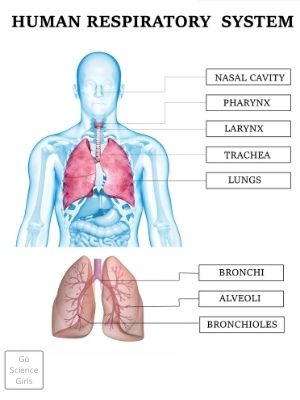
Function of Parts in the Respiratory System
The respiratory system fulfils its responsibility by making sure the organs of the system function coordinate with each other. Functions of each organ play a vital role in purifying the much needed oxygen. Following are the functions of each organ of the respiratory system:
- Nose
The nose enables us to smell things. Ever wondered how? It breathes in air and the hair strands inside the nose obstructs the dust particle we breathe in. Breathing in is also called inhaling.
When we inhale, we breathe in a mixture of gases. This air travels down the respiratory system for further purification. After purification, the air enters the windpipe to leave the human body. This action is called exhalation.
- Windpipe
As the name suggests, it is a long tubular hollow pipe which acts as a passage for purified and impurified air to enter and exit our body.
- Lungs
The lung is a muscular organ filled with or surrounded by blood vessels. The windpipe divides into two and connects to the two parts of our lungs. The muscles in our lungs help us to suck in air from our nostrils by expanding themselves. It also throws out or helps us exhale air by pushing it outwards.
The divided windpipes are called bronchial tubes. These tubes grow thinner and thinner like the arteries forming veins. These tubes branch out like trees, each branch is thinner than the previous one. At the end of the smallest bronchi, we have small balloon-like structures called alveoli.
- Alveoli
These are situated at the very end of the bronchial tubes. They are in hundreds of millions and are ball shaped sacs. The mixture of air enters the alveoli after passing through the windpipe. The walls of the alveoli provide a surface for the exchange of oxygen from air molecules to the blood flowing in the blood vessels.
In this way, the alveoli purifies the inhaled air and transfers the oxygen molecules into the bloodstreams. The air then traces its way back into the windpipe and gets exhaled out from the nostrils.
The respiratory system also helps with our speaking, which we do daily. Our voice travels through the air from our vocal cords to the outside. The vibrations created by the vocal cords are transmitted via air that is exhaled out.
Stomach and Digestive System
The digestive system helps to extract all the nutrients and minerals from the food we eat. The food we eat is broken down into small particles as it passes through various organs of the digestive tract. The digestive tract has walls that contain blood vessels. These blood vessels contain blood which absorbs the nutrients off of the food and uses it to provide energy. This energy is then used by our muscles to perform day to day tasks.
Body Parts in the Digestive System
There are various parts of the digestive system that are responsible for the absorption of different kinds of solids and liquids that we eat every day. The following are the parts of the digestive system:
- Mouth
- Food Pipe
- Stomach
- Small Intestine
- Large Intestine
- Anus
Fun fact: The digestive tract is the longest tract which deforms itself according to the organs mentioned above.
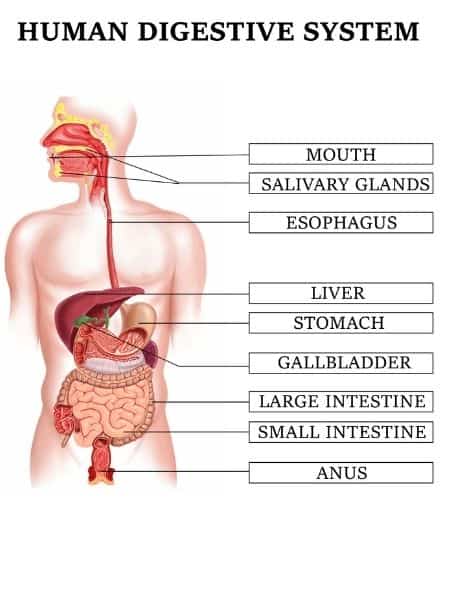
The function of Parts in the Digestive System
Each part of the digestive system has its own secretion of enzymes. Each organ absorbs different kinds of solids and liquids. The functions of each organ are given in detail below.
- Mouth
The mouth is where the process of digestion begins. The walls of the mouth secrete enzymes like saliva that helps moisten the food. The act of chewings breaks down the food into smaller parts. Digestion of starch takes place in our mouth.
- Food Pipe
The act of swallowing food is nothing but passing down food particles from the mouth to the stomach. This is done by the oesophagus. The oesophagus, commonly called as the food pipe, is nothing but a long, muscular passage which allows food to reach the stomach.
- Stomach
The walls of the stomach secrete chemical juices, enzymes, to further break down the food particles. The walls of the stomach are made up of elastic muscles which contract and expand. This motion is called churning of food. Churning helps the food particles to mix with the enzymes and properly disintegrate into smaller particles.
The stomach kills a lot of bacteria in the food consumed.
- Small Intestine
The small intestine is the further extension of the digestive tract. It is shaped like a muscular hollow tube. It looks like it is stuffed within the large intestine.
The walls of the small intestine are muscular and secrete digestive juices. These juices react with the food particle. These juices come from the liver and the pancreas. There are ducts or muscular pipes that bring juices from the respective organ and release it in the small intestine.
The nutrients from the food are absorbed into the walls and into the blood vessels. These nutrients then enter the blood and produce energy. The food particles, mainly liquids, enter the large intestine.
- Large Intestine
This is the last stage where all the nutrients are completely absorbed and the residue is further passed on. The large intestine mainly absorbs liquids like water.
- Anus
This is the end of the digestive system. The residue if solid is called excreta and if liquid, is called urine. The residue enters the urinary system before leaving the body. The body must produce a good amount of waste every day. Only then can we maintain a healthy body.
Kidneys and Urinary System
The urinary system plays a vital role in keeping our body healthy. They take out all the discarded substances from our body and throw them outside. The discarded substances become very harmful to the body if not excreted on a daily basis.
Body Parts in the Urinary system
The urinary system is also known as the urinary tract. The following are the body parts in the urinal system:
- Kidneys
- Ureter
- Urinary Bladder
- Urethra
The function of Parts in the Urinary system
Each organ has a very important role to play when the discarded substance enters the urinary system. The tract basically acts like a drainage system taking all the garbage out of our body. The functions of each organ are mentioned below.
- Kidneys
There are a pair of kidneys, each one on each side. If you know how kidney beans (pulses) look like then you can probably imagine what kidneys look like. Yes! They look exactly like kidney beans. Each kidney is about the size of your computer mouse.
Kidneys filter out the waste out of the blood that enters through the blood vessels. Now the residue that remains is the final waste that the body has to get rid of. If it doesn’t, diseases like diarrhoea and bacterial infections are bound to happen.
- Ureter
The waste that is produced is a mixture of liquids and solids. The liquid makes up the urine or in common terms, pee. The urine, being liquid, slides down a long, muscular tube called the ureter. The ureter just plays the role of passing down the urine from the kidneys to the urinary bladder.
- Urinary Bladder
The urinary bladder stores or collects urine. It is a sac-like organ that holds the urine like a pouch. When the urinary bladder is almost halfway full, it sends a signal to the brain saying that it is time to go pee.
If you do not listen to your brain, the urine has the ability to damage the walls of the urinary bladder which reduces the ability to send signals to the brain.
- Urethra
The urethra is nothing but an opening through which our body gets rid of the urine.
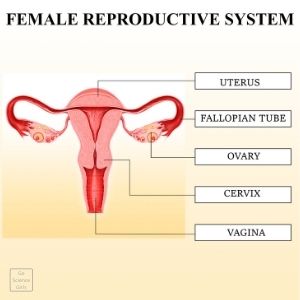
Collection of Human Body Systems Worksheets for Kids
Human Organ Systems – Activity (Name the Organs & Functions) – Worksheet
Female Reproductive System – Worksheet
Human Nervous System (Human Brain) – Worksheet
Human Circulatory System Worksheet
Human Digestive System Worksheet
Human Heart Worksheet
Human Muscular System Worksheet
Human Nervous System Worksheet
Human Respiratory System Worksheet
Human Skeletal Systems Worksheet
No doubt, the human body is a complex combination of the systems we learnt above. All these systems work simultaneously.
To let our system work properly, we must keep it as healthy as possible. Daily exercise helps to keep our bones strong and our body flexible. Daily stretching and running burns away all the junk in our body which helps keep our systems clean.
Eating healthy is also an important habit to inculcate. Keep a watch on your sugar intake. Make sure you are not eating oily or greasy food stuff very often. Fruits and vegetables are a good source of vitamins and minerals. So, make sure your meals include pulses and veggies.
Ask your teachers how to inculcate good eating habits. They will be happy to help you. Don’t stay inside your house all day, instead go out and take a stroll!

